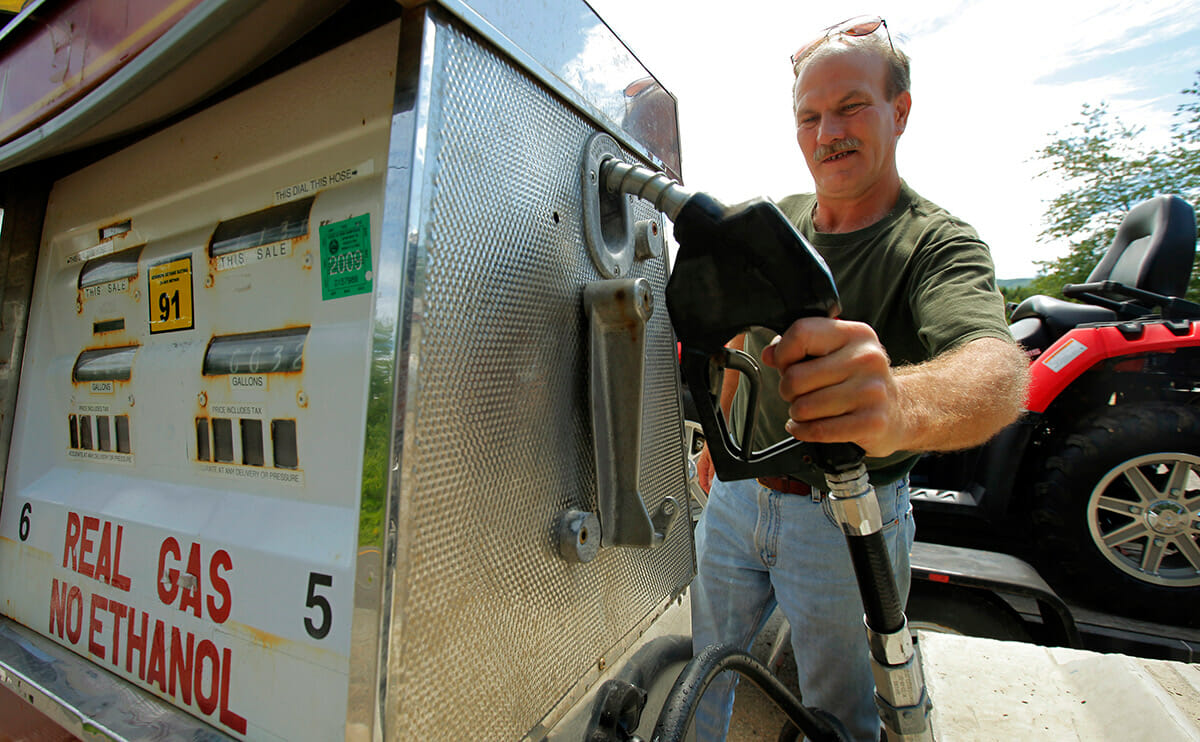Ethanol, which has sent corn prices soaring in recent years, has been a boon to corn farmers. But for others who rely on corn for feed, it's a very different story.

A company called Green Plains was putting the finishing touches on its first ethanol plant on the outskirts of town; bumper stickers and pamphlets lauding the benefits of ethanol featured prominently in the stack of promotional literature the folks at city hall handed me.
Today, that plant in Shenandoah is turning 23 million bushels of corn into 65 million gallons of ethanol per year, and Green Plains now has 12 plants collectively putting out more than 1 billion gallons of ethanol annually. Across the country, more than 200 ethanol plants produced 13.3 billion gallons of ethanol in 2013 ”“ up from 3.9 billion gallons produced in about 90 plants in 2005, when the first federal Renewable Fuels Standard, or RFS, was adopted. That law, updated in 2007, set minimums on the amount of renewable fuels sold annually in the United States, starting at 9 billion gallons in 2008 and increasing each year to 36 billion gallons in 2022. While the law mandated increasing use of ethanol made from cellulose and biodiesel, corn-based ethanol has and continues to account for the vast majority of renewable fuel produced to satisfy these requirements (cost-effective manufacturing of ethanol from other feedstocks remains an elusive goal).
When the RFS was enacted, a bushel of corn cost roughly $2. It has risen dramatically since, hovering for most of the past five years above $5 per bushel and spiking over $8 per bushel in 2012 (when a severe drought crimped the country’s supply).
“If you look back at the past five or six years, those are probably some of the best return years our crop producers have ever captured in the Midwest,” says Chad Hart, an economist at Iowa State University.
But in Virginia, where I live, farmers raise a lot of cattle and chickens and have been singing a very different tune. Those corn price spikes that are a welcome development in Iowa have driven the cost of feed through the roof, much to the dismay of the livestock industry.
Pointing out that ethanol production now consumes more than 40 percent of the American corn crop (up from less than 15 percent in 2005), livestock groups like the National Turkey Federation and the National Beef Cattlemen’s Association directly blame federal ethanol policy for a host of problems and have called for an RFS repeal.
Legislators representing livestock-heavy districts also make continual hay over the issue. Virginian Congressman, Bob Goodlatte (R), regularly puts out press releases decrying the “badly broken federal ethanol policy” and proposing to eliminate the RFS.
These conflicting stances on ethanol are a great illustration of the kinds of economic paradoxes that abound in American agriculture. What’s good for one farmer may well be bad for his neighbor. (Weather offers all kinds of other examples ”“ hot, dry summers are great for wine grapes but not for hay).
But back to ethanol and corn prices. Correlation isn’t necessarily causation, and growing ethanol production has been just one of several factors ”“ energy prices, exports, weather ”“ contributing the past decade’s corn price shocks. A 2012 publication by the USDA’s Economic Research Service cites other studies attributing 20 to 40 percent of the increasing cost of corn to ethanol demand (the studies were looking at different time windows).
“The [feed] price shock that we’ve gone through is certainly not all due to ethanol,” says Tom Stanley, a farm business management agent with Virginia Cooperative Extension. “It’s kind of become a favorite whipping boy of the livestock industry. It clearly has had an impact, but it’s certainly not the only reason why the livestock industry has struggled in terms of feed costs.”
“I don’t like the higher prices we see for grains to fatten beef cattle,” says Irvin Armentrout, a cattle farmer in Virginia’s Shenandoah Valley. “[But] the RFS actually accelerated research and development of seeds with the ability to produce greater yields.”
Things in agriculture tend to see-saw back and forth, and no matter what commodity a given farmer’s selling, there’s bound to be something giving him cause to fret. Livestock farmers with a long view, then, look for the silver lining in high corn prices.
In response to booming demand for corn, seed companies and research institutions are now chasing average corn yields of an astronomical 300 bushels per acre, double the current level. If ethanol policy has contributed to short-term pain for farmers like Armentrout, resulting corn yield increases will be a long-term gain for anyone or anything that grows, eats or otherwise uses corn.
Markets also have a way of responding to sudden changes in things like corn prices. In 2013, farmers planted more than 95 million acres of corn (a larger area than the entire state of Montana). The weather was good and the harvest came in at a record 13.9 billion bushels. Simple laws of supply and demand brought corn prices back down, close to $4 per bushel, even after American refineries turned used over one-third of that record harvest to refine another 13.3 billion gallons of ethanol in 2013.
“Everybody had more than enough [corn] to do what they needed to do,” says Hart, of Iowa State.
Correspondingly, the see-saw is now tipping back in favor of cattle farmers, whose animals also fetched record prices in 2013. Cheaper corn prices have plenty to do with that (but not everything ”“ commodity pricing is complicated deal), and now it’s the beef industry’s turn to be feeling positively bullish about the future.